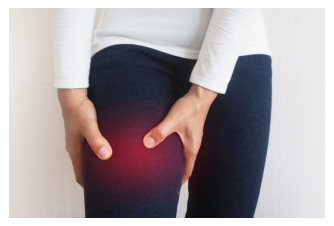Do you occasionally have one-sided hip pain that radiates down the outer portion of your thigh to your knee? Is your pain relieved by icing the affected side, stretching your gluteal muscles, and resting? Has your mobility and life declined due to this pain? If you answered yes to any of these questions, then read the details below about Greater Trochanter Pain Syndrome (GTPS).
What is Greater Trochanter Pain Syndrome?
● Greater trochanter pain syndrome (GTPS) is gradual or acute idiopathic (unknown) pain that occurs on the lateral side of the hip.
● It is believed that GTPS is caused by abnormal hip biomechanics.
o These abnormal hip biomechanics are compressive forces causing impingement of the gluteal tendons and bursa on to the greater trochanter by the iliotibial (IT) band as the hip moves into adduction.
o These compressive forces are increased where there is weakness in the hip abductor muscles due to lateral pelvic tilt.
Signs and Symptoms
● Debilitating chronic intermittent lateral hip, thigh, buttock pain radiates to the knee.
● Pain is aggravated with weight bearing activity on the affected side.
● Decrease in physical activity
● Decline general health
● Decreased employment
● Decline in lifestyle
● GTPS is seen more commonly in females between the ages 40 and 60 years old.
● Greater trochanter pain syndrome may be reproduced on assessment by pressing on areas on the side on the hip and thigh.
● The pain may radiate down the lateral thigh.
● The pain should not radiate to the foot.
Diagnosis
● GTPS is diagnosed with a hip X-ray,
● An ultrasound, and
● Magnetic resonance imaging (MRI).
● Images from these diagnostic tests may reveal fluid-filled and thickened trochanteric bursa with inflammation, tendinopathy, or tears within the gluteal medius or gluteus maximus tendon.
Treatment
● There is no defined treatment protocol for GTPS.
● The treatment plan and goal of GTPS are to manage decreased compressive force across the
greater trochanter by stretching gluteal muscles,
● Weight loss,
● NSAIDs,
● Physical therapy,
● Pain management, ice, and rest.

background using for health care concept.
References
Dean, D. (2020). Trochanteric Bursitis. https://emedicine.medscape.com/article/309286-overview.
Jaojormami. (2021). [Image]. Thigh pain or muscle twitching or muscle cramp in Asian woman with isolated on white background using for health care concept. https://www.shutterstock.com/image-photo/thigh-pain-muscle-twitching-cramp-asian-1353387305.
Reid, D. (2016). The management of greater trochanteric pain syndrome: A systematic literature review. Journal of orthopaedics, 13(1), 15–28. https://doi.org/10.1016/j.jor.2015.12.006.
Speers, C. J., & Bhogal, G. S. (2017). Greater trochanteric pain syndrome: a review of diagnosis and management in general practice. The British journal of general practice : the journal of the Royal College of General Practitioners, 67(663), 479–480. https://doi.org/10.3399/bjgp17X693041.
